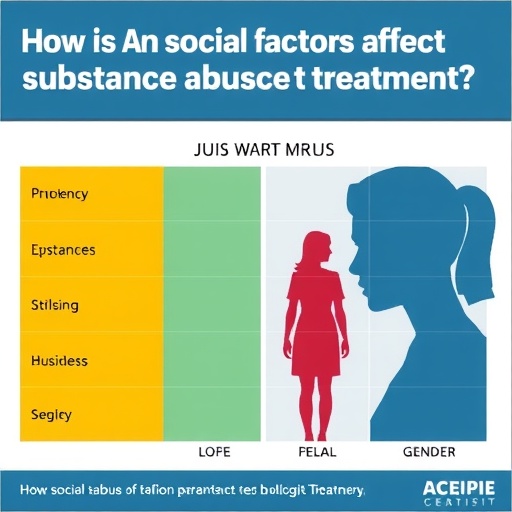In recent years, the intersection between social determinants of health and treatment outcomes for substance use disorders (SUDs) has become a pivotal area of research. A recent study published in Biology of Sex Differences sheds light on an often overlooked but crucial aspect: the impact of sex differences on these outcomes in the context of various social determinants. This research is spearheaded by Chavez, C.L.J., Peltier, M.R., and McKee, S.A., revealing significant insights that could reshape the approach to SUD treatment.
The gravity of substance use disorders cannot be overstated. According to the World Health Organization, SUDs affect millions worldwide, contributing to a range of health issues, social problems, and economic burdens. While notable strides have been made in understanding the biological and psychological ramifications of these disorders, the influence of social factors has garnered increasing attention. This study proposes that gender plays a critical role in how these social determinants influence treatment effectiveness.
Social determinants of health encompass a broad range of non-medical factors that influence health outcomes. These include socioeconomic status, education, neighborhood and physical environment, employment, social support networks, and access to healthcare. The researchers argue that these factors extend beyond demographic categories, profoundly influencing both the onset of SUDs and the effectiveness of their treatment. Their findings underscore the necessity for a gendered lens in tackling these challenges.
The cornerstone of the study revolves around a thorough analysis of existing data on treatment outcomes across different sexes. It explores various determinants, such as access to supportive environments, quality of healthcare, and social support systems, and assesses their differential impacts on males and females. The researchers meticulously draw connections between these determinants and treatment outcomes, highlighting the complexity and variability that exists within and between genders.
One finding indicates that females may face unique barriers that hinder their access to effective treatment. Factors such as child-rearing responsibilities and societal expectations can create additional layers of complexity. Furthermore, the stigma associated with substance use can be amplified for women, potentially leading to lower treatment uptake and poor outcomes. This highlights the necessity of creating gender-sensitive frameworks for substance abuse intervention and support.
Conversely, males often navigate different social challenges that may not be as prevalent in female populations. They may experience stigma associated with vulnerability and seeking help, believing it compromises their masculinity. This cultural aspect can greatly affect their willingness to engage with support systems. The research hints at the importance of crafting tailored messaging and interventions that resonate with male experiences, enhancing their treatment engagement and outcomes.
An interesting aspect of this study is how it integrates behavioral neuroscience to explain these differences. The neurobiological pathways linked to addiction can behave differently in males and females, which could offer insights into why treatment outcomes vary significantly. This biological component adds a layer of complexity to how we understand sex differences in SUDs, emphasizing that both biological and social factors are intertwined.
Moreover, the study includes a thorough exploration of how different types of treatment modalities may yield varying success rates across genders. For instance, therapies that emphasize community-based support and emphasize relational aspects may resonate more effectively with females. In contrast, male participants might benefit more from competition-based or structured environments, presenting a vital area for further investigation.
The implications of these findings stretch far beyond the academic realm. Understanding sex differences in the context of social determinants could lead to the development of innovative treatment programs tailored specifically to meet the needs of different populations. By addressing the unique challenges faced by each gender, healthcare practitioners can offer more effective, empathetic, and comprehensive care, ultimately enhancing treatment outcomes.
In light of these revelations, it is evident that empirical data should inform future health policies and treatment frameworks. Policymakers must consider these findings when developing strategies to combat substance use disorders. Funding initiatives that promote gender-responsive treatment services could catalyze significant improvements in engagement and outcomes for affected populations.
This research serves as a clarion call for collaboration across multiple sectors—healthcare, social work, education, and community organizations—to address the intricate web of social determinants impacting SUD treatment. By fostering partnerships, we can collectively work towards creating environments conducive to recovery and support for all genders.
Collectively, these findings contribute to the increasingly nuanced understanding of substance use disorders, emphasizing that effective treatment is not a one-size-fits-all approach. Instead, it requires a multifaceted perspective that acknowledges both the universal and unique experiences of individuals based on their gender, necessitating tailored interventions to meet their specific needs.
As we look ahead, ongoing research will be crucial for unpacking the multifarious influences of gender on substance use disorder treatment. Continued exploration will provide further clarity and direction for both clinicians and policymakers, nurturing a responsive healthcare system that significantly improves the lives of those grappling with SUDs. This study represents just a step in the journey to comprehensively address the complexities of substance use and treatment through a gender-sensitive lens.
The implications of this groundbreaking research are profound. It emphasizes the need for a transformational shift in how we conceptualize and implement treatment strategies for substance use disorders, integrating gender as a fundamental variable influencing health outcomes. The future of SUD intervention lies not only in understanding the root causes of addiction but also in equally acknowledging and addressing the framework of social determinants that play a crucial role in shaping experiences and recoveries.
In conclusion, the study by Chavez, Peltier, and McKee provides an essential foundation for understanding the differential impacts of social determinants on treatment outcomes for substance use disorders across sexes. The revelations within this research have the potential to initiate profound changes within the healthcare landscape, driving us toward a more inclusive, effective, and empathetic response to a pervasive societal issue that transcends gender boundaries.
Subject of Research: The impact of social determinants of health on substance use disorder treatment outcomes, highlighting sex differences.
Article Title: Sex differences in the impact of social determinants of health on substance use disorder treatment outcomes.
Article References:
Chavez, C.L.J., Peltier, M.R. & McKee, S.A. Sex differences in the impact of social determinants of health on substance use disorder treatment outcomes. Biol Sex Differ 16, 56 (2025). https://doi.org/10.1186/s13293-025-00734-3
Image Credits: AI Generated
DOI: 10.1186/s13293-025-00734-3
Keywords: Substance use disorders, social determinants of health, sex differences, treatment outcomes, gender-sensitive interventions.
Tags: economic burdens of substance abuseeducation and substance use disordersgender differences in treatmentgender-specific treatment strategieshealthcare access and substance useimpact of social support on substance abuseneighborhood effects on health outcomespsychological aspects of substance abuse treatmentsocial determinants of healthsocial factors in addiction recoverysocioeconomic factors in addiction recoverysubstance use disorders treatment



